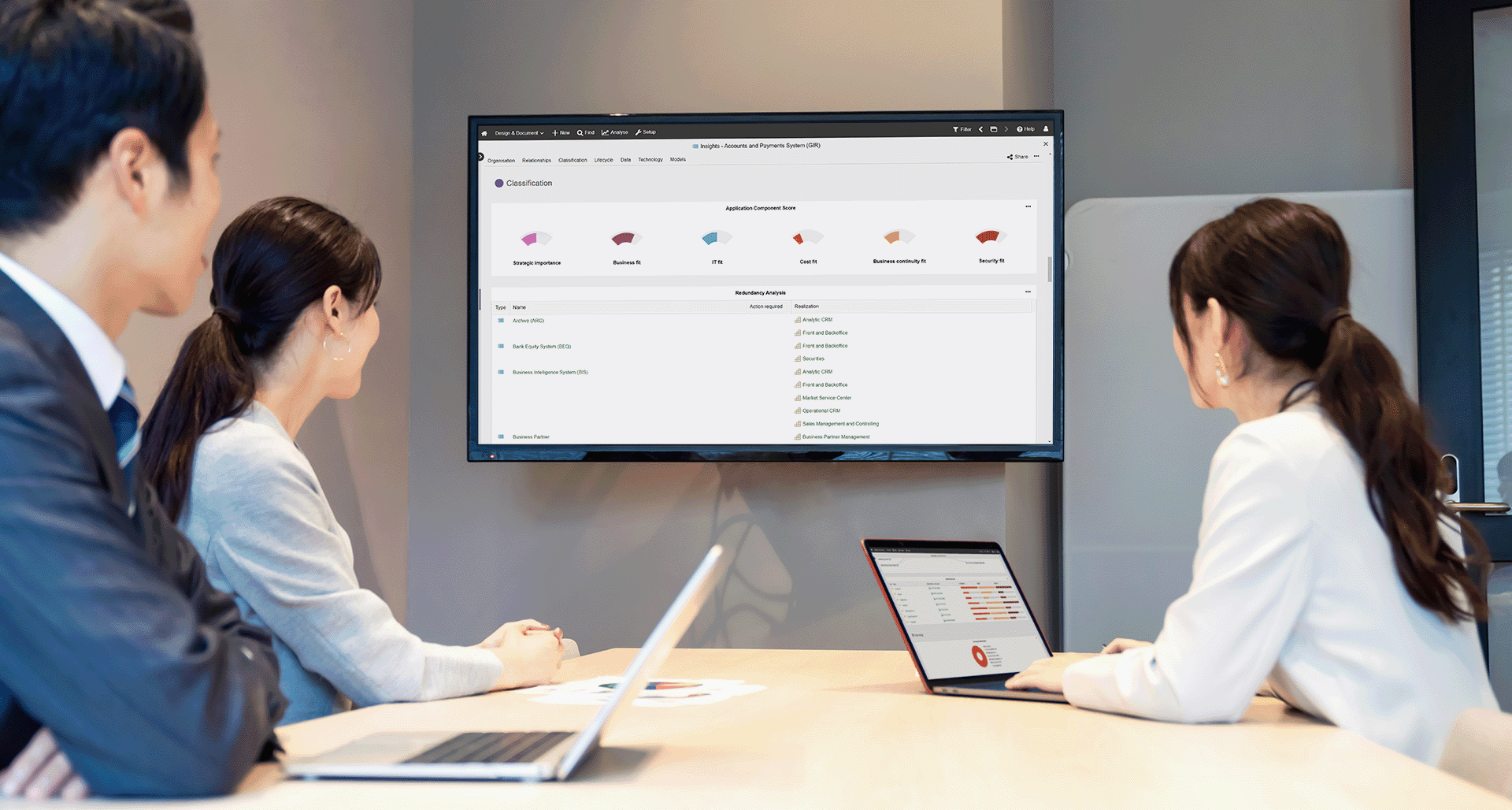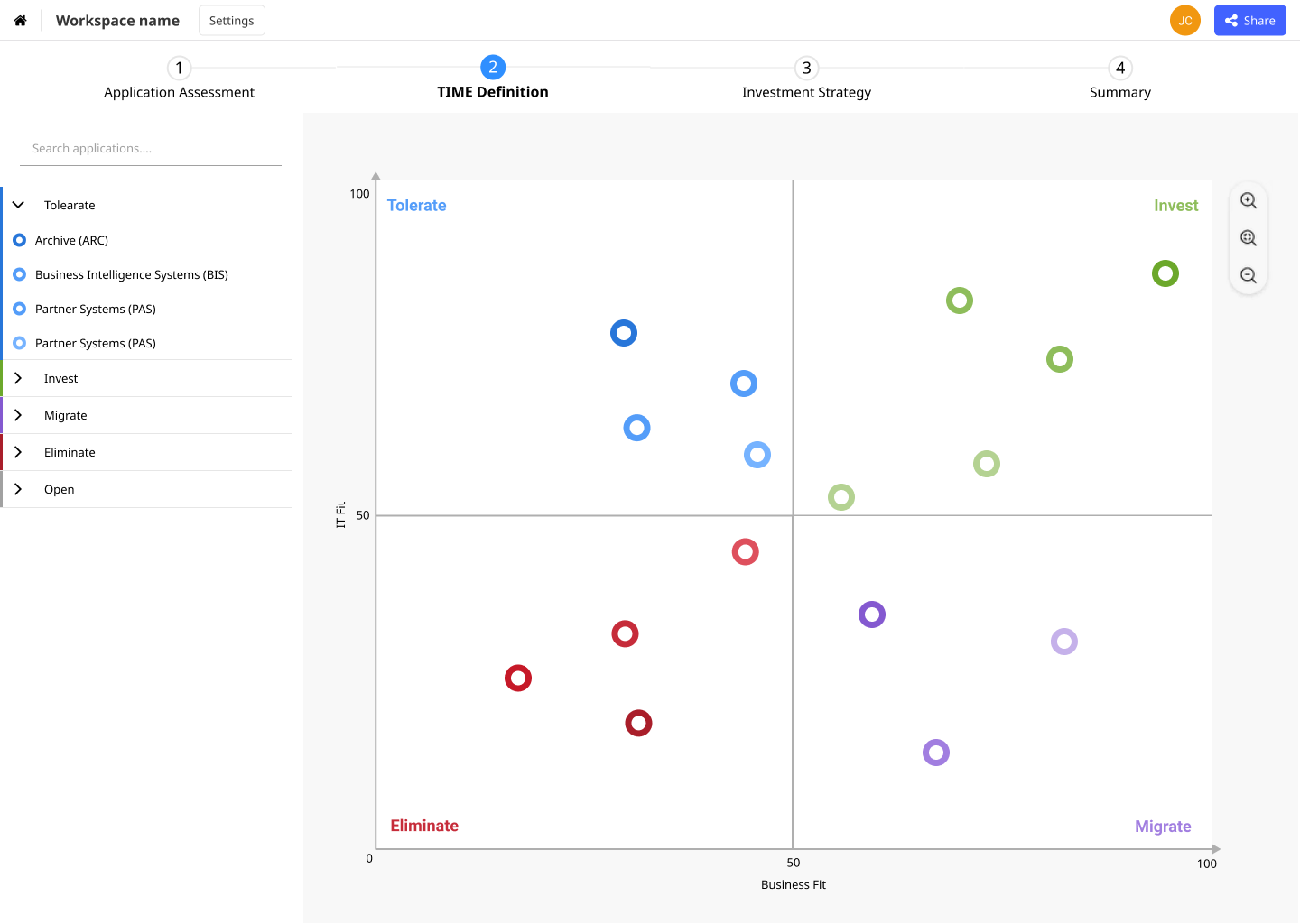Introduction
A structured application portfolio is a powerful driver for the transformation and innovation of your organization, helping you gain a competitive edge over your rivals.
Streamlining of the application landscape helps to reduce costs and resource requirements across the IT, and therefore simultaneously creates more room for innovation. Minimizing the complexity and, as a result, the overall risk of the portfolio is what in the end drives the transformation of your company. can be done in just a few steps, and the first results can be already achieved with little effort.
Before you start, think of a model against which you would like to validate your applications after the assessment. We suggest Gartner’s® TIME model, a 2×2 quadrant showcasing the different investment strategy possibilities based on the applications’ business and IT fitness. The major milestone here, is defining a set of questions that will help you adequately assess the fitness level of each application.
Not sure which key questions to consider? Then keep on reading this blog post, and leverage our 30 best practice criteria to set your application portfolio up for long-term success!

30 Questions To Assess The Fitness Level Of Your Applications
How business-fit are your applications
1. Does the application support one or more of your core processes or capabilities, and to which extent?
A core process is a process that brings value to the customer. Think of all your level 1 processes or capabilities of your process/capability map.
2. Does the application help you gain a competitive advantage?
Some applications are simply a requirement for common processes, while others are unique in their capabilities and as such can bring something new to the table – thus creating a competitive advantage. What about your applications?
3. How serious would a major incident or total failure be for the company?
Think of the consequences that a loss/failure of the application would bring to your organization – specifically in terms of confidentiality, availability or integrity.
4. How much of a value does the application bring to the key users?
Is the application important for key users and to which extent?
5. How successful is the application in realizing your business goals and process requirements?
Consider the degree of fitness between currently supported functionality and your business requirements and process needs. Is there a functional gap you need to cover?
6. How would you evaluate the application’s adaptability?
Think of the degree to which functional enhancements have been met in a timely manner, relative to the number of change requests.
7. How would you rate the application’s functionalities regarding how much knowledge and experience one needs in order to use and manage it?
Some applications are intuitive and easy to use from day one. Others require (some) training. What’s the case with your application at hand?
8. How would you rate the application’s usability and accessibility when it comes to meeting the business and process requirements?
Think about the process of getting used to this application. How would your employees, colleagues or you yourself rate the user friendliness of this application? Is the interface layout easy on the eye and is it intuitive enough?
9. How capable is the application of supporting your information or data management needs?
Consider the following aspects: (1) data integrity and trustworthiness, (2) data quality, (3) availability of data to employees or customers at any time.
10. How does the integration of the application and the business processes across different functional areas look like? Do you find it well-adjusted or not?
Think about the level of (manual) intervention you needed to undertake in order to integrate the application across your organization.
11. Bearing in mind the processes supported by the application, how often do these processes change?
Consider the broader environment surrounding the business processes, including the business strategy adjustments, regulatory updates and economic impacts, as well as operational changes.
12. Is the application important for the business strategy and if so, to which extent?
Does your application contribute to gaining a competitive advantage, or is it simply an application that gets the tasks done?
13. Is there training in place for the end users? If so, how would you evaluate it?
If training is necessary for using the application – is it provided, and are the available resources sufficient for the successful usage of the application?
14. Does this application interfere with other applications?
Think if other applications depend on certain services or data provided by this application.
15. How high are the annual costs related to the application?
Try to gather all the costs for application’s maintenance, remediation, etc. for the past fiscal year.

How IT fit are your applications?
16. How do different business actors, such as its users and stakeholders, interact in order to manage the application?
Consider how business and IT work together to plan, implement, and maintain the application.
17. Is the application capable of efficiently integrating data and processes?
Think of the ease with which the integration can be adjusted to reflect the changing business processes; the degree to which data translations, technology adapters and interfaces are hard coded within the application, or abstracted into the integration hubs.
18. How efficient is the application in protecting your data and keeping it secure?
Think about the access control enforcement, privacy issues, regulatory compliance and how those security controls adversely affect user accessibility, usability, productivity and effectiveness.
19. Are the security checks in place sufficient to ensure the confidentiality and integrity of your application?
Are there any solutions for handling the crisis and recovering the data or is the data loss terminal?
20. How resilient is the application under stressful situations?
Consider the robustness of the application in handling high-transaction volume or congested activity.
21. Is there an overlap between this application’s capabilities and other existing ones?
Is your application unique and if not, is it more valuable than those applications with which it has overlaps?
22. Is this application dependent on obsolete technologies?
Each application is dependent on some technology. Think about the application in question. Is the technology that supports it obsolete?
23. Are there any recurring maintenance or operation issues that can harm or become a hazard to business operations?
Think about the exposure that can occur as a result of using the application.
24. Do upgrades of this application influence other applications?
Consider the consequences of upgrading the application at hand. To what extent does the upgrade influence applications that are used simultaneously?
25. Is the application capable of running on Cloud?
Can you make use of the Cloud technology by using your application?
26. How large is the application’s database?
How many PBs, TBs or GBs of storage does this application require?
27. How compliant is the application with the accepted architecture practices, development principles and technology standards?
Consider whether the application supports the architectural direction of your organization such as Service Oriented Architecture, Business Process Management and Master Data Management.
28. How adaptable to changes is the application and how well does it meet the new requirements?
Are changes made easily or are they difficult and costly? Also consider how well the application handles new requirements.
29. Are there any specific technological knowledge skills required for handling/maintaining the application?
Does the application maintenance and handling require any additional internal or external personnel costs incurred due to necessary know-how?
30. What is the lifecycle state of the application?
Is it at the end-of-life and therefore is losing its business value; at birth and therefore includes formulating the initial business plan; growing and therefore involves improvement and customization or mature and thus is beginning to stabilize its business value?
Define Your Investment Strategy
Once you have evaluated both your business and IT fitness, you can proceed with assigning an for each of them. How? Combine the final scores from both fitness scores and decide if you should:
Tolerate:
Applications with low business value, but high technical quality.
Invest:
Applications with both high business value and high technical quality.
Migrate:
Applications with high business value but low technical quality.
Eliminate:
Applications with both low business value and low technical quality.

Example of a TIME model in the EA Suite ADOIT
For more insights on this topic, check out our blog post on how to define a robust Application Portfolio strategy.
Summary
Performing regular assessments of your application portfolio is critical for keeping pace with rapidly changing markets and making room for new innovations. By asking yourself the right questions and evaluating your applications based on their business and IT fitness, you can identify their value and quality and ultimately guide your portfolio with the right investment strategy.
Are you interested in evaluating your portfolio to identify weak spots, opportunities and room for improvement? Then you should give our industry-renowned EA suite ADOIT a try and its brand-new User Centric Services, where we offer exactly this and much more.
Get our weekly updates.
Never miss the freshest content.







